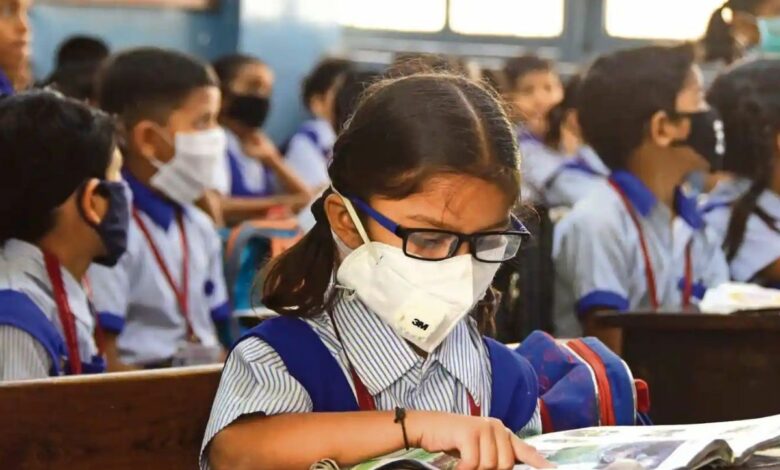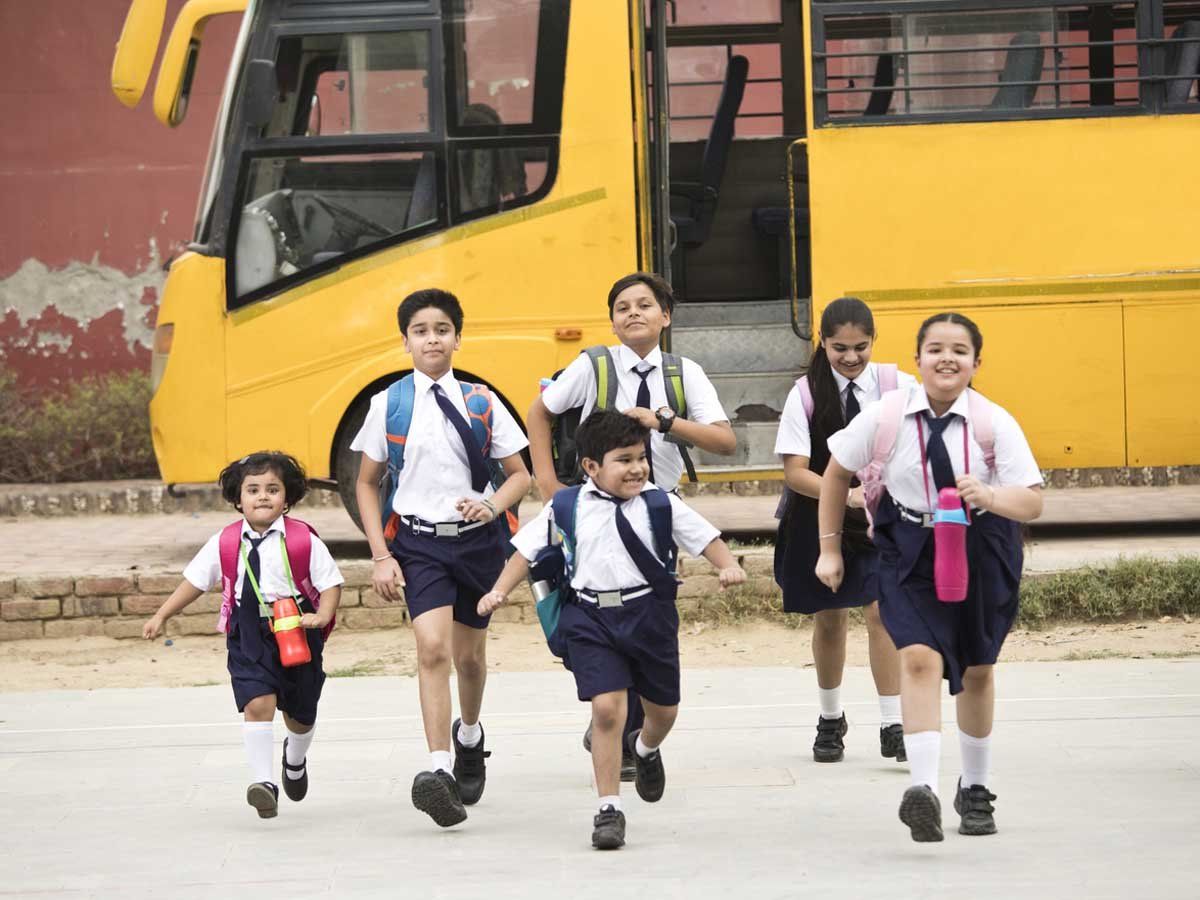Big News: Modi Government Issues SOP to Partially Reopen Schools! Here’s is Everything You Need to Know

The Narendra Modi government issued the Standard Operating Procedure (SoP) on Tuesday to reopen schools for students in grades 9 to 12 on a voluntary basis from September 21. The SOP outlines the general precautions that should be taken in addition to the specific measures that must be adopted when the school allows students (grades 9 to 12) in order to prevent the spread of COVID-19.
It is expected that all States/Union Territories will comply with the COVID-19 related guidelines issued by the Ministry of Health and Family Welfare and Ministry of Home Affairs.

General Precautions
General precautions include simple public health measures, which must be followed to dwindle the risk of COVID-19. Everyone (either teachers, employees, or students) must always comply with these measures.
These include:
i. The use of face masks/masks must be mandatory.
ii. As far as possible, follow a physical distance of at least 6 feet.
iii. Wash your hands often with soap (at least 40-60 seconds), even when your hands are not visibly filthy. When feasible, use an alcohol-based hand sanitizer ( for at least 20-25 seconds).
iv. Breathing etiquette must be strictly observed. This involves strict practices of covering your mouth and nose with a tissue/rag/handkerchief/flexed elbow when sneezing /coughing and properly disposing of the used tissues.
v. Spitting is strictly prohibited.
vi. Everyone should conduct self-monitoring of health and reporting any diseases at the earliest.
vii. Wherever feasible, it is recommended to install and use the Aarogya Setu application.
All Schools (with IX to XII classes) Should Specifically Ensure The Following Arrangements
- Online/distance learning should continue to be encouraged and permitted.
- Students in grades 9 to 12 should be allowed to voluntarily visit their school from September 21 and take guidance from their mentors. This is subjected to the written consent of their parents/guardians. Such visits and teacher-student interaction must be carried out in a staggered manner.
Before Reopening of the Schools
a) Plan to Reopen Schools
- Schools outside the containment area are only permitted to re-open. In addition to this, teachers, students, and employees living in the quarantine area will be prohibited from attending school. Teachers, students, and staff should also be advised not to visit areas falling within the containment area.
- Before restoring partial functioning, educational institutions/schools that were used as isolation centers will be properly deep cleaned and sanitized. Guidelines for the disinfection of public places (including offices) issued by the Ministry of Health and Family Welfare may be referred.
- The concerned non-teaching and teaching staff (up to 50percent of the strength) may be called to schools for online teaching/telephonic consultation and related work.
- Before resuming activities, a 1% sodium hypochlorite solution must use to sanitize all areas (including laboratories) and all other work areas intended for training/demonstrations, etc., with special attention to frequently touched surfaces.
- Students in grades 9 to 12 can choose to take classes virtually/remotely or physically on a voluntary basis for guidance from their mentors, but for that, they must obtain written permission from their parents/guardians and be guided by teachers.
- Instead of biometric attendance, school management shall make other arrangements for contactless attendance.
- Whenever possible, students and teachers should always maintain a physical distance of 6 feet. Schedule activities and seating plans should be made accordingly.
- Make sure to provide handwashing facilities with the provision of soap.
- Sports, assemblies, and other activities that may cause overcrowding are strictly prohibited.
- In order to ensure queue management, on the inside and outside of the premises, specific markings for a 6-foot gap can be marked on the floor. Similarly, physical distancing shall be maintained in office areas, staff rooms (including reception areas), and other places (library, mess, cafeteria, etc.).
- If weather permits, the outdoor space can be used for teacher-student interactions, while paying attention to student security, safety, and physical distance protocols.
- In case of an emergency, the school should display the state helpline number and the number of the local health authority, etc., to students/teachers/employees.
- For ventilation/air conditioning, CPWD’s guidelines must be followed, which emphasizes that the temperature setting of all air conditioning equipment should be in the range of 24-30 C, and the relative humidity should be in the range of 40-70% (intake); as much as possible, intake of fresh air and there should be adequate cross ventilation.
- As long as physical distancing and regular disinfection are maintained, the student lockers will continue to be used.
- Gymnasiums will follow MoHFW guidelines.
- The swimming pool (if applicable) should be kept closed.
b) Planning and Arrangements
All employees who are most at risk, i.e pregnant employees, older employees, and employees with basic medical conditions, should take additional precautions. They should not be exposed to any front-line work that requires direct contact with students. In the online interaction or guidance sessions on the first day, all students and employees can be engaged in the iGOT online module training course on “basic awareness of COVID”.
c) Availability and Management of Supplies

- Personal protective items such as face masks /covers, veneers, hand sanitizers, etc. are made available to teachers and staff by management.
- Provide enough supply of thermal guns, disposable paper towels, soap, alcohol wipes, or 1% sodium hypochlorite solution and IEC materials on COVID.
- A pulse oximeter must be deployed to check the oxygen saturation level of anyone with COVID-19 symptoms.
- Make sure there are enough covered dustbins and trash cans.
- Provision for proper disposal of used personal protective items and general waste in accordance with disposable policy.
- Housekeeping workers will be informed and trained about norms for waste management & disposal.
After the Opening of Schools

A) At the Entry point
- There must be mandatory hand hygiene (disinfectant dispenser) and thermal screening provisions at the entrance. If feasible, separate gates/multiple gates should be used for access.
- Only asymptomatic persons (students and teachers, employees) will be allowed to enter the premises. If any employee/student/teacher is found to have COVID-19 symptoms, they must be referred to the nearest medical center.
- Posters/standees on precautionary measures about COVID-19 are prominently displayed.
- Proper crowd management in corridors, in parking lots, and in elevators – physical distancing norms should be followed appropriately.
- The entry of visitors should be strictly restricted.
B) Conduct instructional activities in rooms or open spaces within the school campus

- For seating arrangements, ensure that the distance between chairs, tables, etc. must be 6 feet.
- Staggered instructional activities are required, with separate time intervals to allow for appropriate physical distancing and disinfection of classroom premises.
- The teaching staff will ensure that they and their students wear masks throughout the teaching/guidance/mentoring activities.
-
Students are not allowed to share notebooks, pens/pencils, erasers, water bottles, and other items.
C) Skill-Based Training in Laboratories/Workshops
- For practical activities in the laboratory, the maximum capacity of each session may be planned and arranged according to the redesigned space.
- Ensure that the type of equipment is disinfected before and after each use, especially the surfaces that are frequently touched.
- Makes sure a floor area of 4m2 each person is available for working on equipment/work station.
- Before and after using the training equipment, make sure that members disinfect their hands. For this purpose, hand sanitizer should be provided at simulation laboratories/workstations, etc.
D) Activities in public areas- Mess/canteen, common room, library, gymnasium, etc.

- People who use public areas must always use a mask/face shield.
- Need to maintain a physical distancing of 6 feet.
- Mess/Cafeteria facilities (if within the premises) should be kept closed.
E) Transportation to and from the Educational Institutions
If the transportation facility is managed by the school, proper physical distancing, disinfection of buses/other vehicles (containing 1% sodium hypochlorite) should be ensured.
F) Sanitation and Hygiene

- The floor should be cleaned every day.
- It must be ensured that sufficient soap is provided in toilets and hand sanitizers in other public areas.
- Regular cleaning and disinfection (using 1% sodium hypochlorite) of often touched surfaces (door handles, elevator buttons, armrests, chairs, benches, toilet fixtures, etc.) in all classrooms, parking spaces, laboratories, lockers, and in other common places, are mandatory, before the start of classes and at the end of the day.
- Computers, teaching materials, laptops, and printers should be disinfected with 72% alcohol wipes.
- Schools must ensure that all drinking and handwashing stations, lavatories, and washrooms will be thoroughly cleaned.
- Employees and students should be instructed to dispose of used face masks/covers in separate covered trash bins in workstations, classrooms, and other public areas. The same can be kept in the trash bin for 3 days and disposed of as dry ordinary solid waste after cutting/shredding.
- For health and safety reasons, students should not engage in any cleaning activities.
Risk Communication
- Create awareness to ensure that students do not gather during their free time and when they leave school.
- Sensitize teachers, students, parents, and employees to build awareness of appropriate behavior for COVID, as described in the general measures above.
- If a teacher, student, or employee is sick, they should not come to the school and follow the specified procedures in this regard.
Psychosocial Welfare
- Ensure that students and teachers who report mental health problems (such as depression and anxiety) are provided with regular consultations.
- It is recommended that school counselors, teachers, and school health workers must work together to ensure the emotional safety of students.
In case a teacher/employee/student develops symptoms such as cough, fever, difficulty breathing), follow the SOP

- Place the patient in a room or area isolated from others.
- Notify parents/guardians as appropriate.
- Patients wearing masks/face shields will remain isolated until they are examined by a doctor.
- Immediately notify the nearest medical institution (hospital/clinic) or call the district or state service helpline.
- The designated public health authorities (regional RRT/treatment physician) should conduct a risk assessment and take further action based on the management of cases, their contact, and the need for disinfection.
- If the person is found to be positive, the place must be disinfected.
Schools that have not released a strategy said they are waiting for state guidelines to decide whether to allow students to return to school.
Ashok Pandey, Director at Ahlcon Group of Schools in Delhi, said, before calling students back to school, we will definitely need parents’ concern, but we have not considered this plan yet. Currently, we are busy with the mid-semester exams, and our online courses are also going very well.
Ameeta Mulla Wattal, the principal of Springdales School in Delhi, said: “As long as the central and state government take the final step, we will prepare to open the schools in accordance with all government guidelines. We will also need parental permission. Without that, we will be unable to do anything.”
However, some principals are totally opposed to the idea of students returning to campus in September.
Keran Bahadur, the principal at Colonel’s Academy in Mhow(in Indore), said: I think in these times when the cases of COVID-19 are surging day by day, we should not call students back to school. In my school, We are not planning to call the students this month, we want to wait for more time and see. Whenever we ask students to come back, we will seek the parents’ NOC (No Objection Certificate).
In July, the Ministry of Education held a virtual conference with all states to ask about their plan to reopen schools. At that time, more than half of the states had not decided on any schedule. However, Haryana, Delhi, and Karnataka states announced they were ready to reopen schools between August and September.




